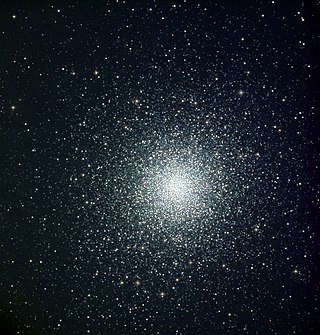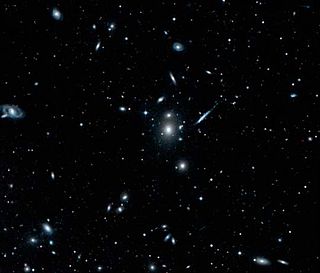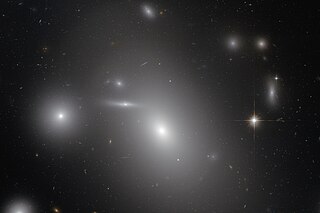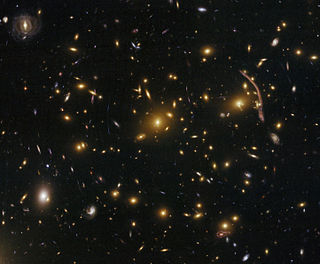
Dark matter is a hypothetical form of matter thought to account for approximately 85% of the matter in the universe. Dark matter is called "dark" because it does not appear to interact with the electromagnetic field, which means it does not absorb, reflect, or emit electromagnetic radiation and is, therefore, difficult to detect. Various astrophysical observations – including gravitational effects which cannot be explained by currently accepted theories of gravity unless more matter is present than can be seen – imply dark matter's presence. For this reason, most experts think that dark matter is abundant in the universe and has had a strong influence on its structure and evolution.

Galaxy groups and clusters are the largest known gravitationally bound objects to have arisen thus far in the process of cosmic structure formation. They form the densest part of the large-scale structure of the Universe. In models for the gravitational formation of structure with cold dark matter, the smallest structures collapse first and eventually build the largest structures, clusters of galaxies. Clusters are then formed relatively recently between 10 billion years ago and now. Groups and clusters may contain ten to thousands of individual galaxies. The clusters themselves are often associated with larger, non-gravitationally bound, groups called superclusters.

Star clusters are large groups of stars held together by self-gravitation. Two main types of star clusters can be distinguished: globular clusters are tight groups of ten thousand to millions of old stars which are gravitationally bound, while open clusters are more loosely clustered groups of stars, generally containing fewer than a few hundred members, and are often very young. Open clusters become disrupted over time by the gravitational influence of giant molecular clouds as they move through the galaxy, but cluster members will continue to move in broadly the same direction through space even though they are no longer gravitationally bound; they are then known as a stellar association, sometimes also referred to as a moving group.

A gravitational lens is a distribution of matter or a point particle between a distant light source and an observer that is capable of bending the light from the source as the light travels toward the observer. This effect is known as gravitational lensing, and the amount of bending is one of the predictions of Albert Einstein's general theory of relativity. Treating light as corpuscles travelling at the speed of light, Newtonian physics also predicts the bending of light, but only half of that predicted by general relativity.

A galaxy cluster, or a cluster of galaxies, is a structure that consists of anywhere from hundreds to thousands of galaxies that are bound together by gravity, with typical masses ranging from 1014 to 1015 solar masses. They are the second-largest known gravitationally bound structures in the universe after galaxy filaments and were believed to be the largest known structures in the universe until the 1980s, when superclusters were discovered. One of the key features of clusters is the intracluster medium (ICM). The ICM consists of heated gas between the galaxies and has a peak temperature between 2–15 keV that is dependent on the total mass of the cluster. Galaxy clusters should not be confused with galactic clusters (also known as open clusters), which are star clusters within galaxies, or with globular clusters, which typically orbit galaxies. Small aggregates of galaxies are referred to as galaxy groups rather than clusters of galaxies. The galaxy groups and clusters can themselves cluster together to form superclusters.

The Spring Triangle is an astronomical asterism involving an imaginary triangle drawn upon the celestial sphere, with its defining vertices at Arcturus, Spica, and Regulus. This triangle connects the constellations of Boötes, Virgo, and Leo. It is visible in the evening rising in the southeastern sky of the Northern Hemisphere between March and May and setting until August, while at morning rising and setting from November to the end of February.

Gravitational microlensing is an astronomical phenomenon due to the gravitational lens effect. It can be used to detect objects that range from the mass of a planet to the mass of a star, regardless of the light they emit. Typically, astronomers can only detect bright objects that emit much light (stars) or large objects that block background light. These objects make up only a minor portion of the mass of a galaxy. Microlensing allows the study of objects that emit little or no light. Gravitational microlensing was first theorised by Refstal (1964) and first discovered by Irwin et al (1988). The first object in the sky where it was discovered was the Einstein cross or Huchra lens 2237 +0305. The initial lightcurve of the object was published by Corrigan et al (1991). In Corrigan et al (1991) they calculated that the object causing the microlensing was a Jupiter sized object. This was the first discovery of a planet in another galaxy.

Abell 1689 is a galaxy cluster in the constellation Virgo over 2.3 billion light-years away.

The Comet Galaxy, a spiral galaxy located 3.2 billion light-years from Earth, in the galaxy cluster Abell 2667, was found with the Hubble Space Telescope. This galaxy has slightly more mass than our Milky Way. It was detected on 2 March 2007.

The Leo Cluster is a galaxy cluster about 330 million light-years distant in the constellation Leo, with at least 70 major galaxies. The galaxy known as NGC 3842 is the brightest member of this cluster. Along with the Coma Cluster, it is one of the two major clusters comprising the Coma Supercluster, which in turn is part of the CfA2 Great Wall, which is hundreds of millions light years long and is one of the largest known structures in the universe.

NGC 4889 is an E4 supergiant elliptical galaxy. It was discovered in 1785 by the British astronomer Frederick William Herschel I, who catalogued it as a bright, nebulous patch. The brightest galaxy within the northern Coma Cluster, it is located at a median distance of 94 million parsecs from Earth. At the core of the galaxy is a supermassive black hole that heats the intracluster medium through the action of friction from infalling gases and dust. The gamma ray bursts from the galaxy extend out to several million light years of the cluster.

While the presence of any mass bends the path of light passing near it, this effect rarely produces the giant arcs and multiple images associated with strong gravitational lensing. Most lines of sight in the universe are thoroughly in the weak lensing regime, in which the deflection is impossible to detect in a single background source. However, even in these cases, the presence of the foreground mass can be detected, by way of a systematic alignment of background sources around the lensing mass. Weak gravitational lensing is thus an intrinsically statistical measurement, but it provides a way to measure the masses of astronomical objects without requiring assumptions about their composition or dynamical state.

Abell 370 is a galaxy cluster located nearly 5 billion light-years away from the Earth, in the constellation Cetus. Its core is made up of several hundred galaxies. It was catalogued by George Abell, and is the most distant of the clusters he catalogued.

MACS J0717.5+3745 is a large galaxy cluster located 5.4 billion light years away in the constellation Auriga, appearing in the Massive Cluster Survey (MACS).

El Gordo is the largest distant galaxy cluster observed at its distance or beyond, as of 2011. As of 2014, it still holds the record for being the largest distant galaxy cluster to have been discovered with a mass of three quadrillion suns. It was found by NASA's Chandra X-ray Observatory, Atacama Cosmology Telescope—funded by National Science Foundation, and European Southern Observatory's Very Large Telescope.

RX J1347.5–1145 is one of the most massive galaxy clusters known discovered in X-rays with ROSAT. As a result, it is also one of the most X-ray-luminous because of its hot gas content. The object resides roughly 5 billion light-years away from the Solar System in the constellation of Virgo. Redshift was noted as z=0.451 with an X-ray luminosity of 1045 ergs s−1 in a paper from 2002. In 2013, one study found eight cases of the same object resulting from the intense gravitational bending of light, which makes it possible to identify a series of remote galaxies located inside the galaxy cluster with calculations from the photometric method between 5.5 and 7.5. That study made use of data from Cluster Lensing and Supernova survey with Hubble (CLASH) as well as other sources. The colors in the galaxy cluster are known to correspond with the level of brightness, or the number of electrons trapped in the examined wavelength range of the cluster, with the colors red, orange, and yellow as high intensity, blue-green and green as medium intensity, and blue and violet as low intensity. It is considered one of the brightest objects that is known by X-ray.

ESO 146-5 is the designation given to a giant interacting elliptical galaxy in the center of the Abell 3827 cluster. It is well noted due to its strong gravitational lensing effect, measurements of which show the galaxy to be one of the most massive in the known universe.

MACS J0416.1-2403 is a cluster of galaxies at a redshift of z=0.397 with a mass 160 trillion times the mass of the Sun inside 200 kpc (650 kly). Its mass extends out to a radius of 950 kpc (3,100 kly) and was measured as 1.15 × 1015 solar masses. The system was discovered in images taken by the Hubble Space Telescope during the Massive Cluster Survey, MACS. This cluster causes gravitational lensing of distant galaxies producing multiple images. Based on the distribution of the multiple image copies, scientists have been able to deduce and map the distribution of dark matter. The images, released in 2014, were used in the Cluster Lensing And Supernova survey with Hubble (CLASH) to help scientists peer back in time at the early Universe and to discover the distribution of dark matter.

The XDCPJ0044.0-2033 (Gioello) galaxy cluster at redshift z=1.579 was discovered in the archive of the XMM-Newton mission, as part of the XMM-Newton Distant Cluster Project (XDCP) and first published by Santos et al. 2011. Gioiello is the most distant massive galaxy cluster that has been found and studied today. This massive galaxy cluster contains 400 trillion times the mass of the Sun and is located 9.6 billion light years away from Earth. The name Gioiello, meaning "jewel" in Italian, was given to this massive galaxy cluster because an image of the cluster contains many beautiful pink, purple, and red sparkling colors from the hot X-ray–emitting gas and other star-forming galaxies within the cluster.

NGC 4660 is an elliptical galaxy located about 63 million light-years away in the constellation Virgo. The galaxy was discovered by astronomer William Herschel on March 15, 1784 and is a member of the Virgo Cluster.


















